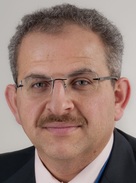Canterbury > Private Hospitals & Specialists > Southern Cross Hospitals >
Southern Cross Christchurch Hospital - Vascular Surgery
Private Surgical Service, Vascular Surgery
Description
Southern Cross Hospital in Christchurch is the largest hospital within our national network.
Owned by Southern Cross since 1979, the centrally situated hospital campus includes one of the biggest and most advanced private surgical hospitals in the South Island.
The Christchurch hospital campus has seen significant upgrades and new facilities in recent years, and typically provides services to around 9,500 patients each year. Facilities include digital operating theatres, an advanced 'hybrid' operating room, systems for robotically-assisted surgery, advanced digital scanning technologies, consulting facilities and a purpose built endoscopy centre.
Consultants
-

Mr Timothy Beresford
Vascular Surgeon
-

Mr Adib Khanafer
Vascular Surgeon
-

Mr Peter Laws
Vascular Surgeon
-

Professor Justin Roake
Vascular Surgeon
Procedures / Treatments
Endovascular therapy: a long thin tube (catheter) is inserted through a small incision (cut) made in the groin in the groin. The catheter is guided to the site of the aneurysm and a graft (synthetic tube) or stent (a metal tube) is put in place to relieve the pressure on the aneurysm. Conventional: an incision is made in the abdomen or chest and the weakened part of the aorta is replaced with a graft.
Endovascular therapy: a long thin tube (catheter) is inserted through a small incision (cut) made in the groin in the groin. The catheter is guided to the site of the aneurysm and a graft (synthetic tube) or stent (a metal tube) is put in place to relieve the pressure on the aneurysm. Conventional: an incision is made in the abdomen or chest and the weakened part of the aorta is replaced with a graft.
Endovascular therapy: a long thin tube (catheter) is inserted through a small incision (cut) made in the groin in the groin. The catheter is guided to the site of the aneurysm and a graft (synthetic tube) or stent (a metal tube) is put in place to relieve the pressure on the aneurysm.
Conventional: an incision is made in the abdomen or chest and the weakened part of the aorta is replaced with a graft.
Carotid Endarterectomy: an incision (cut) is made along the side of the neck, the carotid artery opened and the fatty material (plaque) removed. The artery is closed with a patch. Minimally invasive: a long thin tube (catheter) is inserted through a small incision made in the groin. The catheter is guided to the carotid artery where a balloon attached to the catheter is inflated to clear the blockage or a small metal tube (stent) is put in place to hold the blood vessel open.
Carotid Endarterectomy: an incision (cut) is made along the side of the neck, the carotid artery opened and the fatty material (plaque) removed. The artery is closed with a patch. Minimally invasive: a long thin tube (catheter) is inserted through a small incision made in the groin. The catheter is guided to the carotid artery where a balloon attached to the catheter is inflated to clear the blockage or a small metal tube (stent) is put in place to hold the blood vessel open.
Carotid Endarterectomy: an incision (cut) is made along the side of the neck, the carotid artery opened and the fatty material (plaque) removed. The artery is closed with a patch.
Minimally invasive: a long thin tube (catheter) is inserted through a small incision made in the groin. The catheter is guided to the carotid artery where a balloon attached to the catheter is inflated to clear the blockage or a small metal tube (stent) is put in place to hold the blood vessel open.
Balloon Angioplasty: a long thin tube (catheter) with a tiny balloon attached to the tip is inserted through a small incision (cut) made over an artery in your arm or groin. The catheter is guided through the arteries to the site of the blockage where the balloon is inflated to clear the blockage and, in some cases, a metal tube (stent) is inserted into the artery to keep it open. Endarterectomy: incisions are made in the affected limb and artery and the fatty material (plaque) in the blood vessel is removed. Bypass Surgery: a piece of a vein from another part of the body or a tube made of synthetic material (graft) is used to join the artery above and below the narrowed or blocked section. This creates a detour and a new path for the blood to flow around the blocked segment.
Balloon Angioplasty: a long thin tube (catheter) with a tiny balloon attached to the tip is inserted through a small incision (cut) made over an artery in your arm or groin. The catheter is guided through the arteries to the site of the blockage where the balloon is inflated to clear the blockage and, in some cases, a metal tube (stent) is inserted into the artery to keep it open. Endarterectomy: incisions are made in the affected limb and artery and the fatty material (plaque) in the blood vessel is removed. Bypass Surgery: a piece of a vein from another part of the body or a tube made of synthetic material (graft) is used to join the artery above and below the narrowed or blocked section. This creates a detour and a new path for the blood to flow around the blocked segment.
Balloon Angioplasty: a long thin tube (catheter) with a tiny balloon attached to the tip is inserted through a small incision (cut) made over an artery in your arm or groin. The catheter is guided through the arteries to the site of the blockage where the balloon is inflated to clear the blockage and, in some cases, a metal tube (stent) is inserted into the artery to keep it open.
Endarterectomy: incisions are made in the affected limb and artery and the fatty material (plaque) in the blood vessel is removed.
Bypass Surgery: a piece of a vein from another part of the body or a tube made of synthetic material (graft) is used to join the artery above and below the narrowed or blocked section. This creates a detour and a new path for the blood to flow around the blocked segment.
Balloon Angioplasty: a long thin tube (catheter) with a tiny balloon attached to the tip is inserted through a small incision (cut) made over an artery in your arm or groin. The catheter is guided through the arteries to the site of the blockage where the balloon is inflated to clear the blockage and, in some cases, a metal tube (stent) is inserted into the artery to keep it open. Endarterectomy: incisions are made in the affected limb and artery and the fatty material (plaque) in the blood vessel is removed. Bypass Surgery: a piece of a vein from another part of the body or a tube made of synthetic material (graft) is used to join the artery above and below the narrowed or blocked section. This creates a detour and a new path for the blood to flow around the blocked segment.
Balloon Angioplasty: a long thin tube (catheter) with a tiny balloon attached to the tip is inserted through a small incision (cut) made over an artery in your arm or groin. The catheter is guided through the arteries to the site of the blockage where the balloon is inflated to clear the blockage and, in some cases, a metal tube (stent) is inserted into the artery to keep it open. Endarterectomy: incisions are made in the affected limb and artery and the fatty material (plaque) in the blood vessel is removed. Bypass Surgery: a piece of a vein from another part of the body or a tube made of synthetic material (graft) is used to join the artery above and below the narrowed or blocked section. This creates a detour and a new path for the blood to flow around the blocked segment.
Balloon Angioplasty: a long thin tube (catheter) with a tiny balloon attached to the tip is inserted through a small incision (cut) made over an artery in your arm or groin. The catheter is guided through the arteries to the site of the blockage where the balloon is inflated to clear the blockage and, in some cases, a metal tube (stent) is inserted into the artery to keep it open.
Endarterectomy: incisions are made in the affected limb and artery and the fatty material (plaque) in the blood vessel is removed.
Bypass Surgery: a piece of a vein from another part of the body or a tube made of synthetic material (graft) is used to join the artery above and below the narrowed or blocked section. This creates a detour and a new path for the blood to flow around the blocked segment.
Sclerotherapy: a tiny needle is used to inject a chemical solution into the vein that causes the vein to collapse. This approach is recommended for small varicose veins only. Vein stripping: the varicose veins are cut out and the veins that branch off them are tied off. The cuts (incisions) made in the skin are closed with sutures. Phlebectomy: small cuts (incisions) are made in the leg and the varicose veins are pulled out with a tiny hook-like instrument. The cuts are closed with tape rather than sutures and, once healed, are almost invisible.
Sclerotherapy: a tiny needle is used to inject a chemical solution into the vein that causes the vein to collapse. This approach is recommended for small varicose veins only. Vein stripping: the varicose veins are cut out and the veins that branch off them are tied off. The cuts (incisions) made in the skin are closed with sutures. Phlebectomy: small cuts (incisions) are made in the leg and the varicose veins are pulled out with a tiny hook-like instrument. The cuts are closed with tape rather than sutures and, once healed, are almost invisible.
Sclerotherapy: a tiny needle is used to inject a chemical solution into the vein that causes the vein to collapse. This approach is recommended for small varicose veins only.
Vein stripping: the varicose veins are cut out and the veins that branch off them are tied off. The cuts (incisions) made in the skin are closed with sutures.
Phlebectomy: small cuts (incisions) are made in the leg and the varicose veins are pulled out with a tiny hook-like instrument. The cuts are closed with tape rather than sutures and, once healed, are almost invisible.
Visiting Hours
Weekdays 8:00 to 20:00
Weekends 8:00 to 20:00
Public Transport
The Christchurch City Council provides good public transport information. See here
Parking
Over 60 parking spaces are provided for patients and visitors.
Pharmacy
Contact Details
Southern Cross Christchurch Hospital
Canterbury
-
Phone
(03) 968 3100
-
Fax
(03) 968 3101
Email
Website
131 Bealey Avenue
Christchurch Central
Christchurch
Canterbury 8013
Street Address
131 Bealey Avenue
Christchurch Central
Christchurch
Canterbury 8013
Postal Address
P.O. Box 21-096,
Edgeware,
Christchurch, 8143
Was this page helpful?
This page was last updated at 1:51PM on May 22, 2025. This information is reviewed and edited by Southern Cross Christchurch Hospital - Vascular Surgery.

